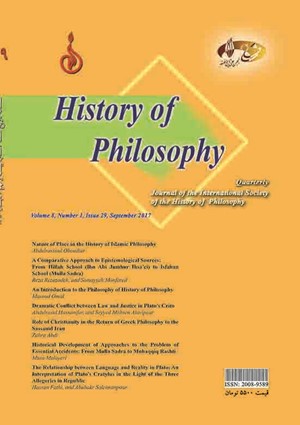-
-
List of Articles
-
Open Access Article
1 - The Relationship between Language and Reality in Plato: An Interpretation of Plato’s Cratylus in the Light of the Three Allegories in Republic
Hassan Fathi Aboubakr Soleymanpour -
Open Access Article
2 - Foreword
Hossein Kalbasi Ashtari -
Open Access Article
3 - Nature of Place in the History of Islamic Philosophy
Abdulrassoul Oboudiat -
Open Access Article
4 - A Comparative Approach to Epistemological Sources: From Hillah School (Ibn Abi Jumhur Ihsa’ei) to Isfahan School (Mulla Sadra)
Reza Rezazadeh Somayyeh Monfared -
Open Access Article
5 - An Introduction to the Philosophy of History of Philosophy
Masoud Omid -
Open Access Article
6 - Dramatic Conflict between Law and Justice in Plato’s Crito
Abdulrasul Hasanifar Seyyed Mohsen Alavipour -
Open Access Article
7 - Role of Christianity in the Return of Greek Philosophy to the Sassanid Iran
Zahra Abdi -
Open Access Article
8 - Historical Development of Approaches to the Problem of Essential Accidents: From Mulla Sadra to Muhaqqiq Rashti
Moosa Malayeri -
Open Access Article
9 - The Relationship between Language and Reality in Plato: An Interpretation of Plato’s Cratylus in the Light of the Three Allegories in Republic
Aboubakr Soleymanpour
-
The rights to this website are owned by the Raimag Press Management System.
Copyright © 2017-2026







